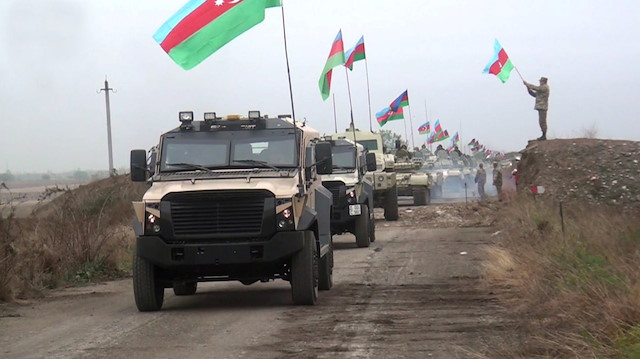

A still image from a video released by Azerbaijan's Defence Ministry shows military vehicles driving along a road as Azerbaijan army units enter the Aghdam region of Nagorno-Karabakh
Azerbaijani army enters Aghdam, eastern Nagorno-Karabakh, with Azerbaijani, Turkish flags after 27 years of occupation
The Aghdam district in Azerbaijan was handed Friday to its rightful owners, Azerbaijanis, after being occupied for 27 years since Armenian forces took control of the region in 1993.
The success of the Azerbaijani army in an operation to save its territory in Nagorno-Karabakh from occupation, launched Sept. 27, forced Armenia to sign a cease-fire deal.
Armenian forces left Aghdam on Nov. 20, according to the armistice.
Along with Armenian forces, the Armenian population who settled in the region during the occupation also left.
The Azerbaijani army entered Aghdam with tanks and armored vehicles with Azerbaijani and Turkish flags.
Agdam, in the east of Nagorno-Karabakh, was a buffer zone between the Azerbaijani army and Armenian forces during the occupation.
After the collapse of the Soviet Union, Armenian forces, which carried out attacks on Azerbaijani territory, occupied Khankendi in 1991, Khojaly and Shusha in 1992, and entered Aghdam in 1993 after Lachin, Khojavend, Kalbajar and Aghdere.
In the city center and more than 100 villages, as many as 143,000 Azerbaijanis resided there before the occupation.
About 5,000 Azerbaijanis were murdered in defense of the city.
Nearly 73% of Aghdam was occupied by Armenia.
The Armenian administration relocated Armenians brought in from different regions in the district.
During the occupation, Armenians destroyed historical and cultural monuments belonging to Azerbaijanis and almost destroyed the city center.
The Great Mosque of Aghdam, which was opened for worship in 1870, the Aghdam bread museum and the Aghdam Ethnographic Museum, as well as historical artifacts were destroyed.
The destruction by Armenians in Aghdam during the occupation was described in the foreign press as the "Hiroshima of the Caucasus."
Armenians continued to wreak havoc before Nov. 20 -- the deadline set to evacuate, according to the cease-fire.
Houses were set on fire, trees were felled and infrastructure was damaged. The animals they couldn't take with them were destroyed.
In Aghdam, the Azerbaijani army will clear mines and repair infrastructure.
More than 200,000 Aghdamans forced to live away from their land for 27 years, will be able to return to their homes after securing the region.
Relations between the former Soviet republics of Azerbaijan and Armenia have been tense since 1991 when the Armenian military occupied Nagorno-Karabakh, also known as Upper Karabakh, a territory recognized as part of Azerbaijan, and seven adjacent regions.
New clashes erupted Sept. 27 and the Armenian army continued its attacks on civilians and Azerbaijani forces, even violating humanitarian cease-fire agreements for 44 days.
Baku liberated several cities and nearly 300 settlements and villages from the Armenian occupation during this time.
On Nov. 10, the two countries signed a Russia-brokered agreement to end fighting and work toward a comprehensive resolution.
#Agdam
#Armenia
#Azerbaijan
#cease-fire
#liberation
#occupation

